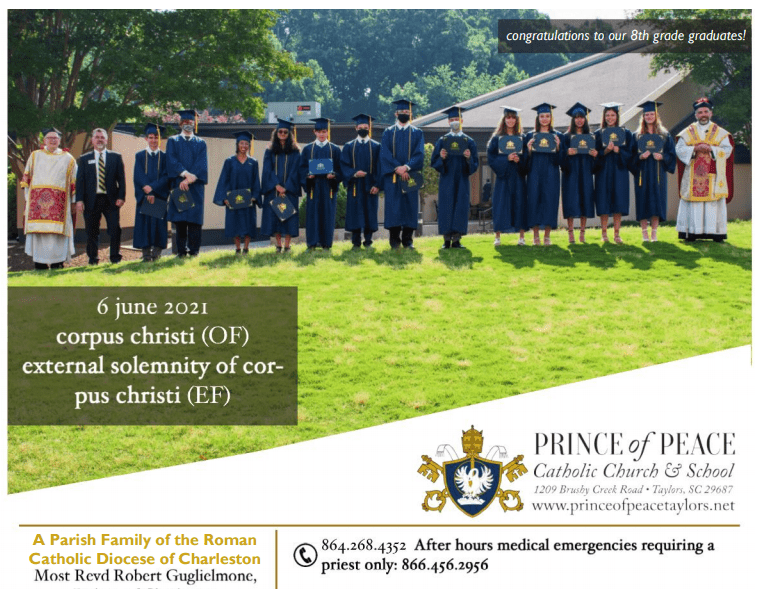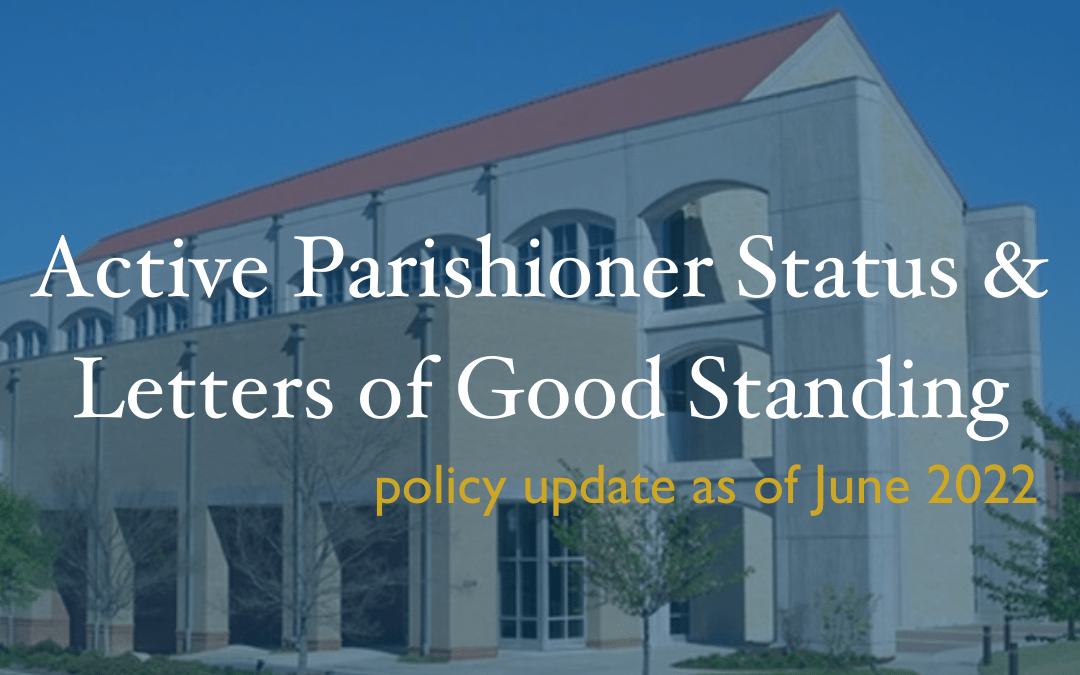

Contact Prince of Peace
"*" indicates required fields

6 June 2021 Bulletin
Click to read this weekend’s bulletin: 6 June 2021 Bulletin

Policy: Active Parishioner Status (updated June 2021)
Active Parishioner Status and Letters of Good Standing
In order to be considered an active parishioner of Prince of Peace, you must do the following for at least six months:
- Register in the parish with the registration form found online or in the narthex
- Assist at Mass at Prince of Peace at least 75% of all Sundays and Holy Days.
- Contribute financially and by being an active part of parish life
- Use the envelope system to track attendance, even if your financial contribution is by electronic means, if you are ever going to need a letter of good standing. In the future, if an electronic means of check in is provided, that suffices for Mass attendance tracking.
A letter of good standing from Prince of Peace indicates that the records of the parish indicate fulfillment of all requirements for active parishioner status for at least six months. A letter of good standing is necessary for the following:
- to have a baby baptized in any Catholic church
- to serve as a godparent at baptism or sponsor at confirmation in any Catholic church
- to get married in any Catholic church
- to receive the active parishioner discount at Prince of Peace Catholic School
Active members are marked inactive in the rolls of the parish:
- if requested
- if after six months there is no trackable giving or envelope usage
All Catholics aged 18 or older should register under their own name with the parish they consider their spiritual home. Catholics over the age of 18 who consider Prince of Peace their spiritual home, but are under their parents’ care and are away at school, military or civil service, should register in the parish and indicate that fact for our records.
Sick, homebound, or shut-in parishioners who are unable to fulfill the requirements for active parishioner status will not be marked inactive if they or their families communicate to the parish that they wish to remain active.
Inactive parishioners who may not qualify for a letter of good standing may always receive the sacraments of Holy Communion, Penance, Anointing of the Sick, as well as receive ecclesiastical funerals and burials. They will not be allowed to receive the sacraments of Baptism or Matrimony, serve as a godparent for Baptism or Confirmation, or receive the parishioner discount in the school, until six months of active parishioner status has been demonstrated.
These policies are almost universal in the United States, where they are a local means of applying certain dispositions of canon law to protect the integrity of the sacramental order. They are part of the ecclesiastical discipline of the Church which expects adult Catholics to be mature and active members of their parish family, indicating a minimum level of practice to receive the sacraments.
Please remember that the letter of good standing is not issued based on any particular priest’s recollection of your Mass attendance; it is based on 75% Mass attendance each Sunday using the envelope system and recorded by the parish. Some people give weekly, biweekly, monthly, quarterly, or even yearly. The letter of good standing is based, not on the frequency or amount of giving (although that should reflect a mature understanding of biblical principles of stewardship), but on Mass attendance. Now that more and more people are using electronic forms of giving, there has to be a way to track weekly Mass attendance. Right now, the only way to do this is by the use of envelopes.
If you give electronically, you may drop your offertory envelope with a 0-online giving note in the offertory basket when you come. If you forget your envelope, there are some available on the credenzas in the narthex. We have a subcommittee of the parish staff looking into the possibility of electronic forms of check-in for Sunday Mass attendance; when we decide on a platform for that, this policy will be updated and the faithful notified.
Sometimes people have specific individual or family situations that mean that one or more four requirements for active parishioner status is not possible or unduly burdensome. If you communicate in a general way to the parish office the reason for that situation, we can notate our records to that effect, so that you will not be rendered inactive if you wish to remain active.
If you change your address, email address, or phone number, please notify the parish as soon as possible. If you move away from the parish, then please do so as well.
Thank you in advance for your cooperation with these policies. They are not there to make life burdensome. Instead, they are part of that ecclesiastical discipline which is a sign of true communion of heart and mind with your local Church and a maturity of faith measured, not in terms of minimalism, but authentic Catholic practice
Policy updated as of June 2022.
Contact Prince of Peace
"*" indicates required fields
11 June: Solemnity of the Most Sacred Heart of Jesus & 12 June: Feast of the Immaculate Heart of Mary
11 June: Solemnity of the Most Sacred Heart of Jesus. This Solemnity is celebrated on the Friday after the Feast of Corpus Christi. The Sacred Heart is depicted as a flaming heart surrounded by a crown of thorns, with a cross on top and bleeding from a wound. (It is often displayed with the Immaculate Heart of Mary, which is also on fire, surrounded by a crown of flowers and pierced by a sword.) This feast was celebrated in seventeenth century France at the request of St. John Eudes. But the history of this devotion goes much farther back; it was highlighted by the fathers of the Church, including Origen, St. Ambrose, St. Jerome, St. Augustine, St. Hippolytus, St. Irenaeus, St. Justin Martyr, and St. Cyprian. This devotion was also given form in the 12th century by St. Bernard of Clairvaux in his famous “O Sacred Head Surrounded.” In 1673, Jesus appeared to a French nun, St. Margaret Mary Alacoque. He told her that he wished to be honored in Eucharistic adoration during a holy hour on Thursdays, that he desired a feast day devoted to his Sacred Heart, and that he desired the faithful to receive Holy Communion on first Fridays. It took years, but eventually devotion to the Sacred Heart spread throughout the world. In 1856, Pope Pius IX established the Feast of the Sacred Heart as obligatory for the whole Church.
12 June: Feast of the Immaculate Heart of Mary. In the midst of WWII, Pope Pius XII put the whole world under the protection of our Savior’s Mother by consecrating it to her Immaculate Heart. He decreed that the Church should celebrate the Feast of the Immaculate Heart of Mary so as to obtain by her intercession “peace among nations, freedom for the Church, the conversion of sinners, the love of purity and the practice of virtue” (Decree of May 4, 1944). This is not a new devotion; in the seventeenth century, St. John Eudes preached it together with that of the Sacred Heart; in the nineteenth century, Pius VII and Pius IX allowed a feast of the Pure Heart of Mary. In Scripture, Simeon’s prophecy portrayed Mary with her heart pierced with a sword; and at the foot of the Cross, we are shown the Heart of Mary. Mary was not merely passive at the crucifixion, “she cooperated through charity” as St. Augustine says, “in the work of our redemption.”
Both of these feasts use the heart as a symbol of love. In the Sacred Heart, the emphasis is on God’s love and mercy. Love so intense that the symbol is a human heart encircled with a crown of thorns, crowned with a cross, and radiating flames: this is how much Christ loves us. Devotion to the Immaculate Heart stems from Mary’s privileged status as the Mother of God. She provides a model for what our own hearts should look like. Devotion to the Sacred Heart is one of gratitude for Jesus’ great love for us; devotion to the Immaculate Heart indicates our desire to emulate the way in which Mary loves Jesus.
Ideas for celebrating these feast days at home:
- Food ideas: make Heart-Shaped Pizza. Bake a heart-shaped cake or cookies. Make an Immaculate Heart out of fruit and a Sacred Heart out of veggies. Serve red meat, red jello, or any other red or heart-themed foods.
- Read The 12 Promises of the Sacred Heart of Jesus. Learn about the practice of First Friday and First Saturday devotions.
- Read the Scripture readings of the day, which you can find at usccb.org. The readings for the Solemnity include a beautiful Sequence that you can sing or pray before your evening meal.
- Make valentines from Jesus to each child or family member, with a message echoing the theme of Christ’s infinite love for us. For a craft, make hearts with Mexican Tin Art, instructions here.
- Consecrate your family to the Sacred Heart of Jesus and the Immaculate Heart of Mary. Do a home Enthronement, instructions here.
- Read Enthronement of the Sacred Heart of Jesus: Sacred Scripture by Cardinal Raymond Burke.
(sources: teachingcatholickids.com; The Catholic All Year Compendium; Catholic Encyclopedia, 1913 ed.; catholicculture.org)
Recent Comments